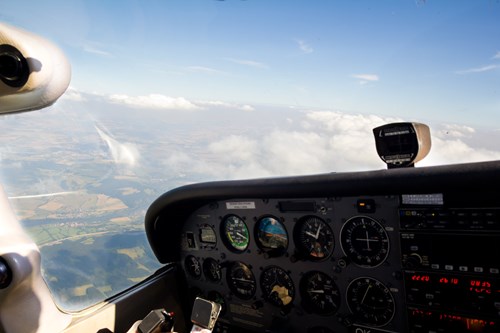Industry collaboration on avionics paves the way for GAINS navigation demonstration flights

The GAINS project has moved one step closer to demonstrating that general aviation (GA) is able to fly instrument procedures with radius-to-fix (RF) legs, thanks to a strong collaboration with EASA and the manufacturing industry, who worked together to clear the way for existing avionics to be used.
GAINS – General Aviation Improved Navigation and Surveillance, is a project co-funded by the SESAR Joint Undertaking under the European Union’s Horizon 2020 research and innovation programme. It aims to validate concepts enabled by Global Navigation Satellite System (GNSS) and EGNOS and has now reached the navigation demonstration phase.
A key technical enabler for this is the ability of GA aircraft avionics to use RF legs, which are curved paths flown with precision using GNSS navigational guidance. In the past, RF legs were only viable for airliners equipped with expensive avionics. Today, theoretically, most GA aircraft using performance-based navigation in Europe with much more affordable avionics would also be able to fly it. However, until February 2019, EASA still required that RF leg capability be disabled in these devices. This was a barrier to large-scale navigation demonstrations for GAINS.
Following meetings with the GAINS team in early 2019, EASA worked closely together with one of these manufacturers, Garmin, to enable the use of GTN-series navigators to fly RF legs. Garmin amended its master drawing list (now 005-00533-C0 Rev 22) and its installation checklist (190-01007-E1 Rev 10), to allow RF leg navigation with GTN-series navigators under EASA STC 10037574. On 8 March 2019, the first aircraft registered in an EASA member state with this modification was released to service, and it will take part in the GAINS navigation demonstration flights.
Commented GAINS project director Philip Church: “The GAINS project is very grateful to the Garmin and EASA teams for their timely action, which will enable the use of SESAR solutions[i] for enhanced terminal operations by GA aircraft, and ultimately bring us one step closer to demonstrating how GA can also benefit with better airspace integration. We are delighted that GAINS has been a trigger for a widespread change to avionics regulations for GA and that EASA was proactive in delivering that change.”
By testing flights with a broad variety of GA equipment, GAINS will demonstrate the ability of GA to employ new technology and procedures in flight, and also test the viability of adapting SESAR solutions to improve GA’s operations and integration within a variety of operational contexts and environments. This should contribute to better GA integration at controlled and uncontrolled aerodromes, as well as improving safety, efficiency and predictability of operations.







.png)
.jpg)

Comments
There are no comments yet for this item
Join the discussion